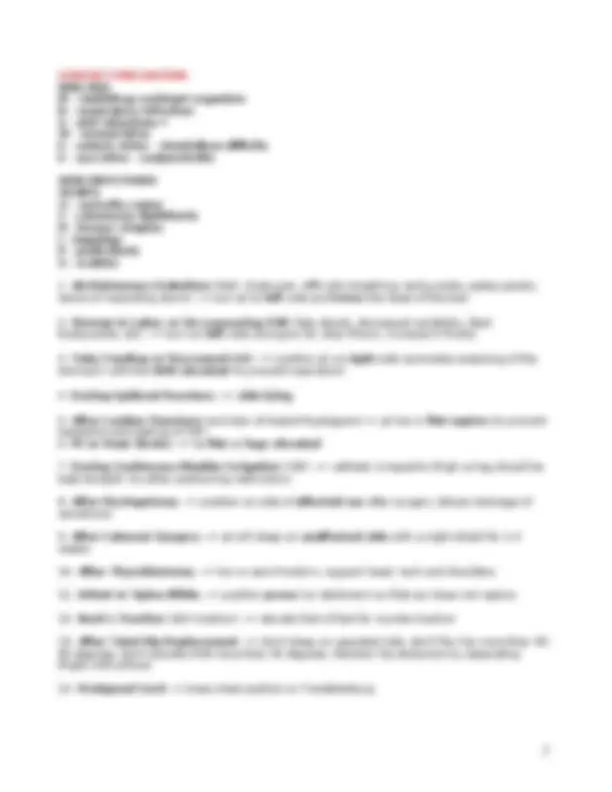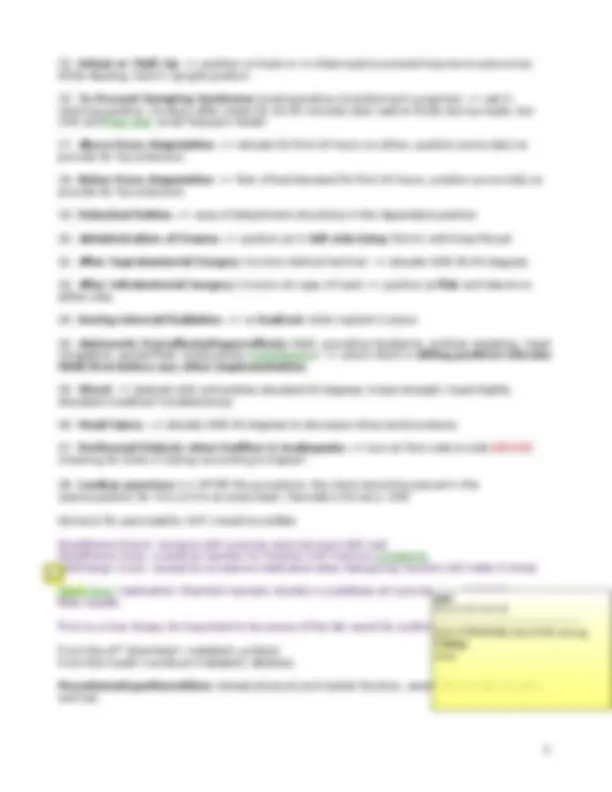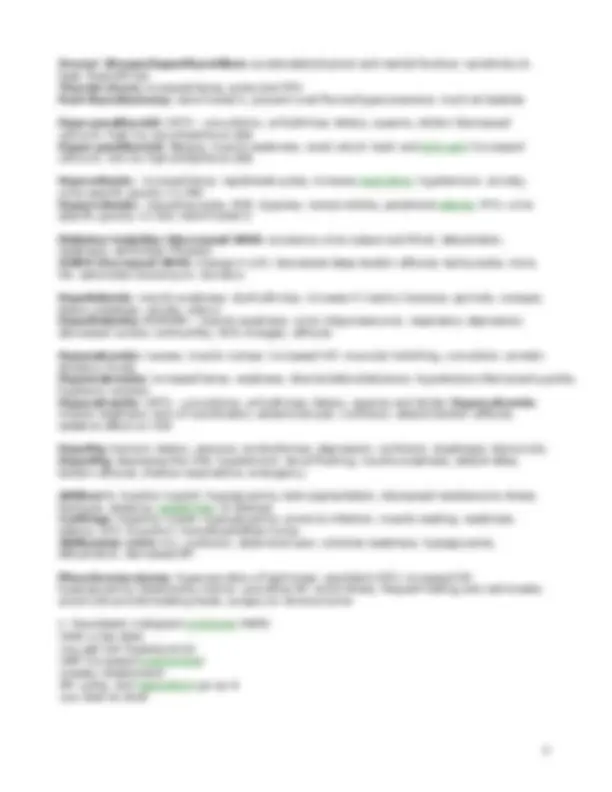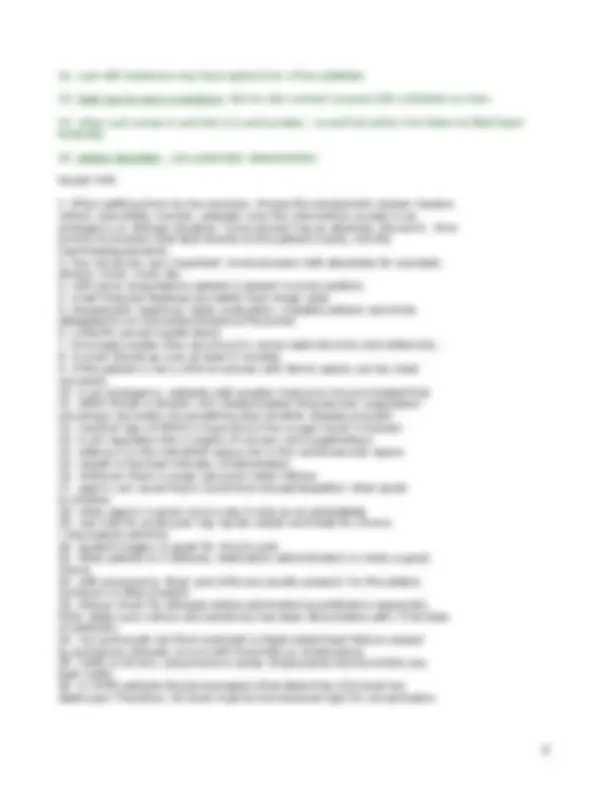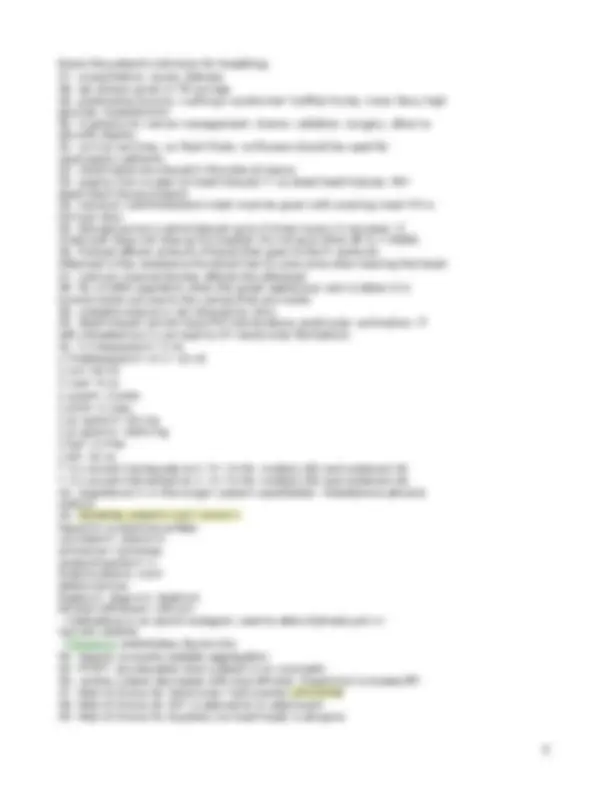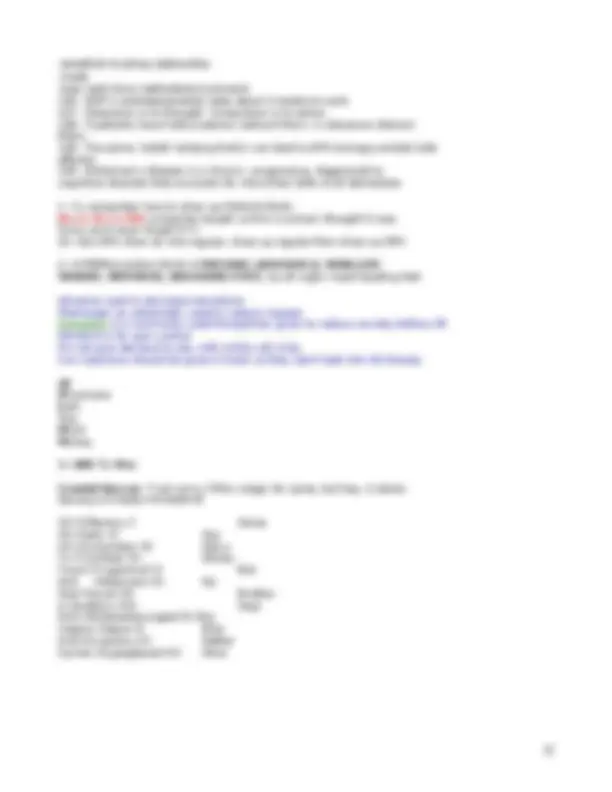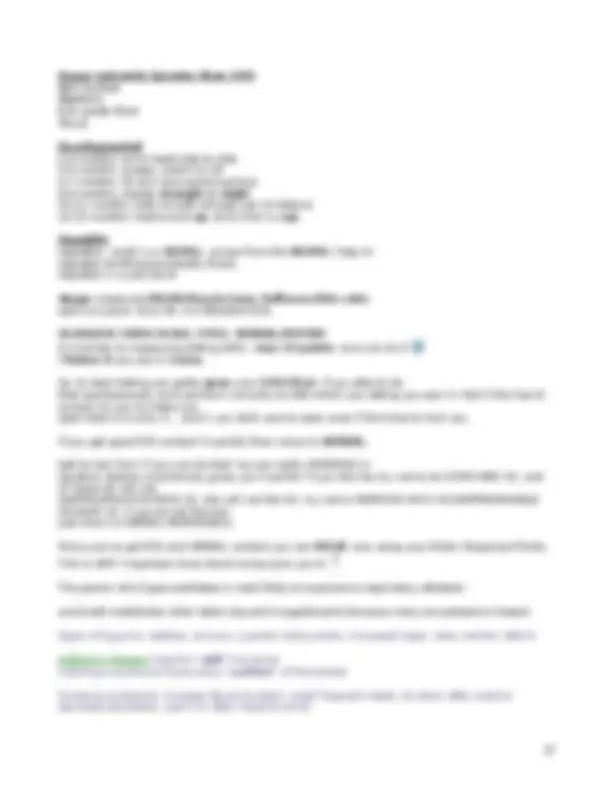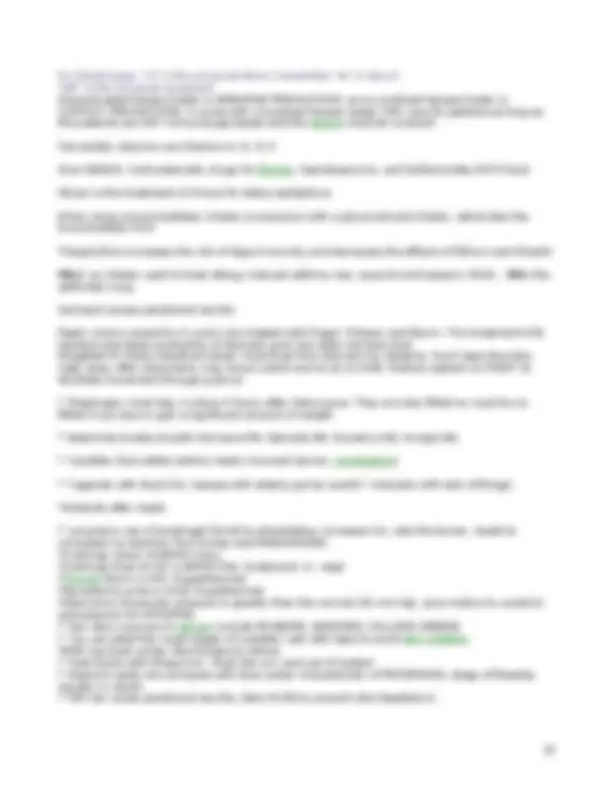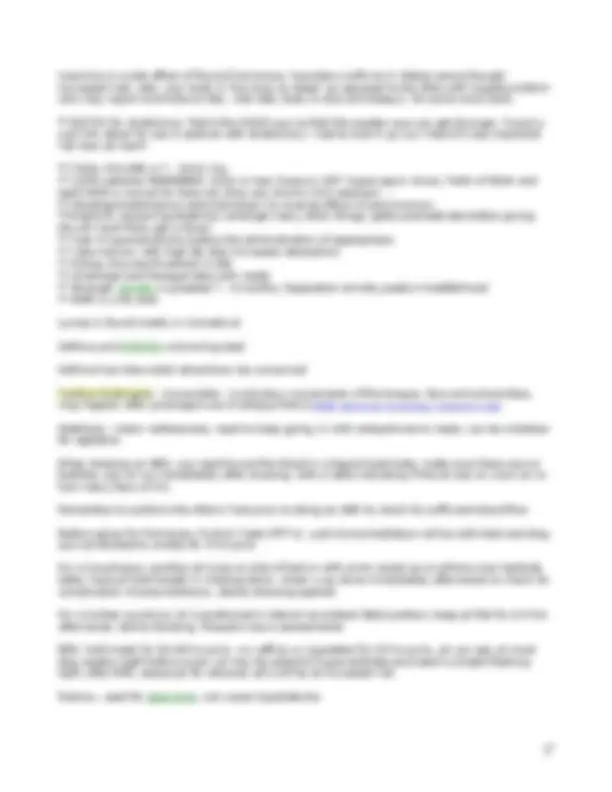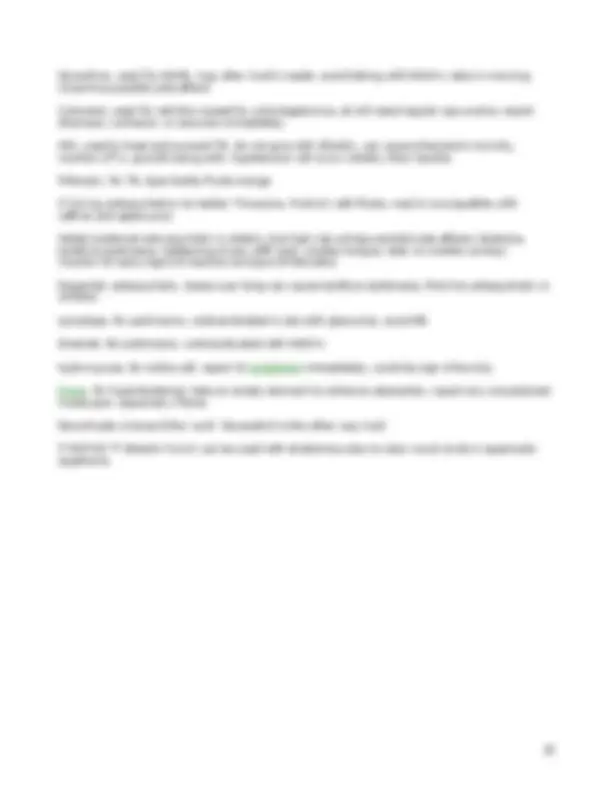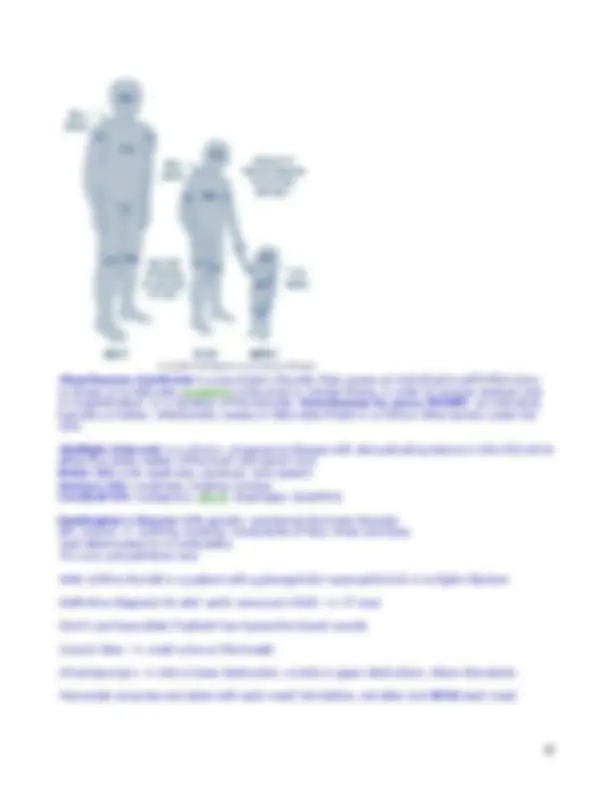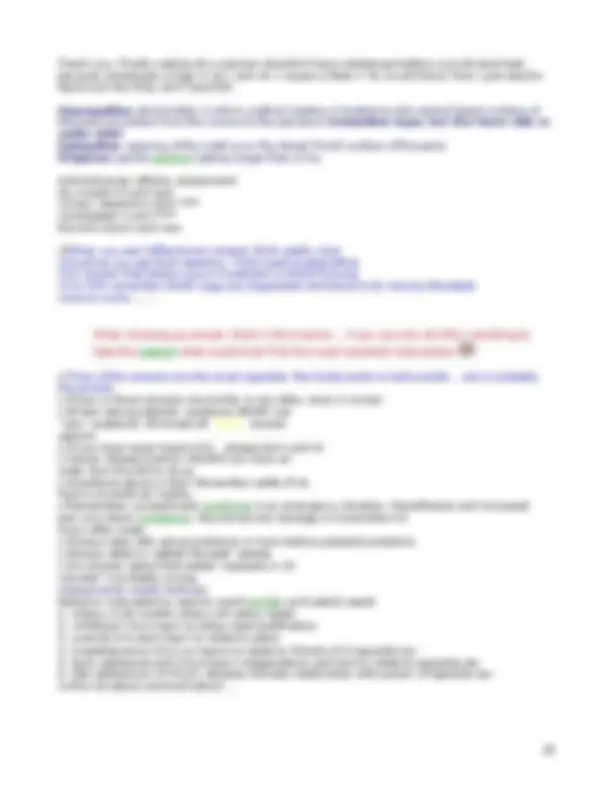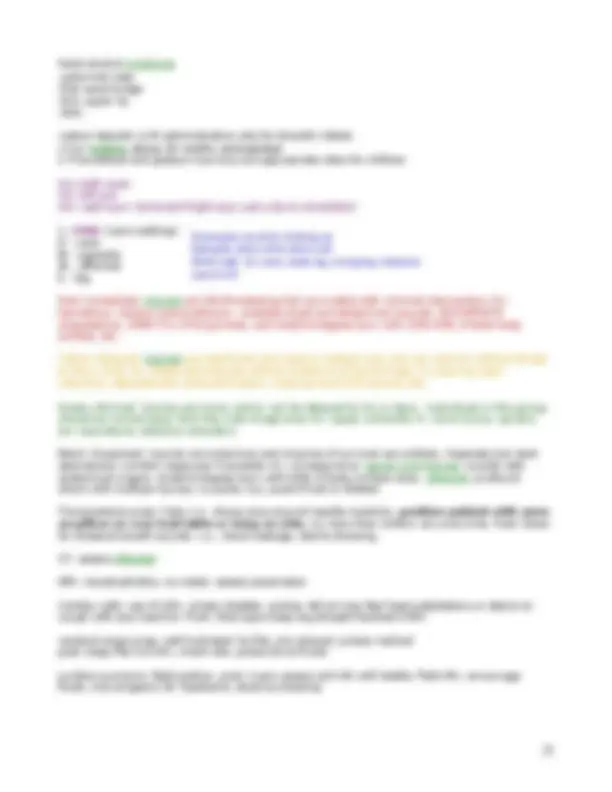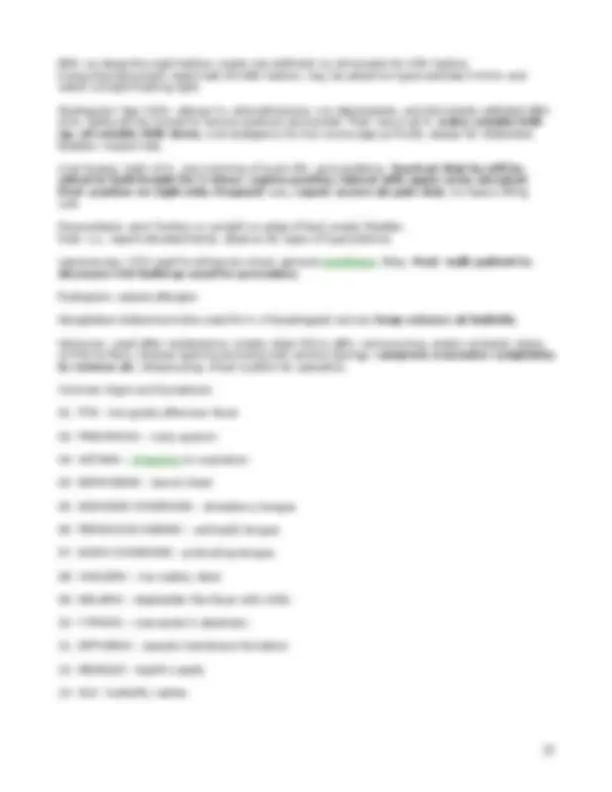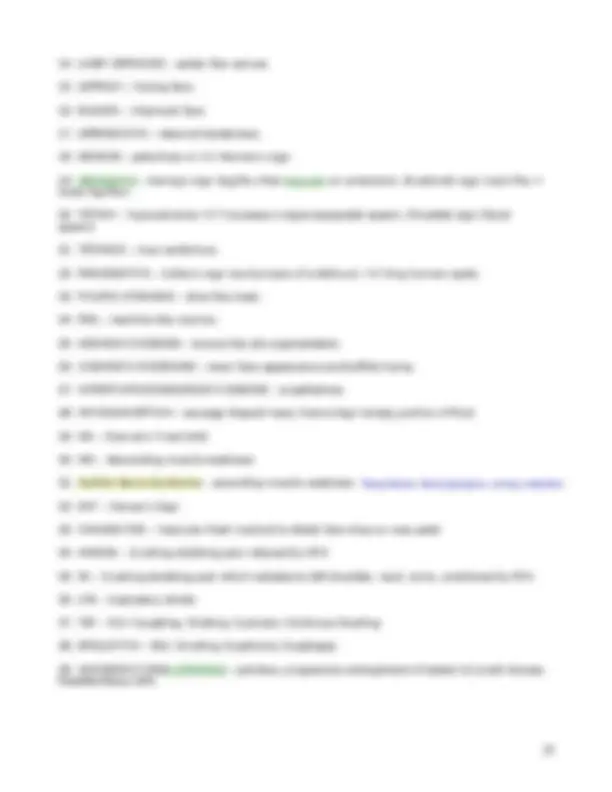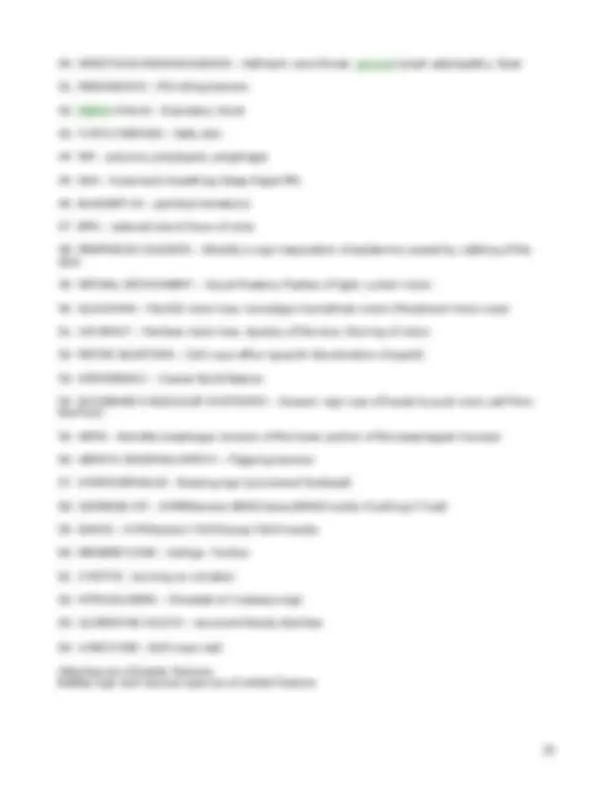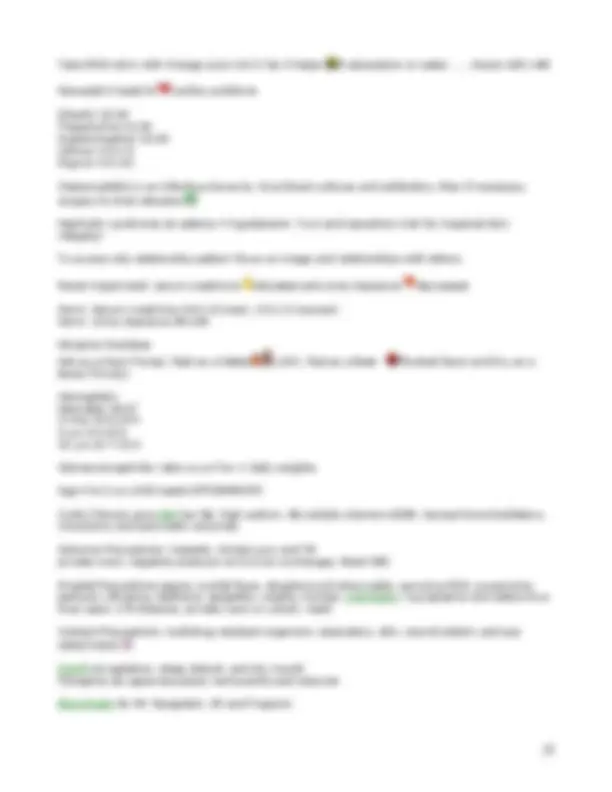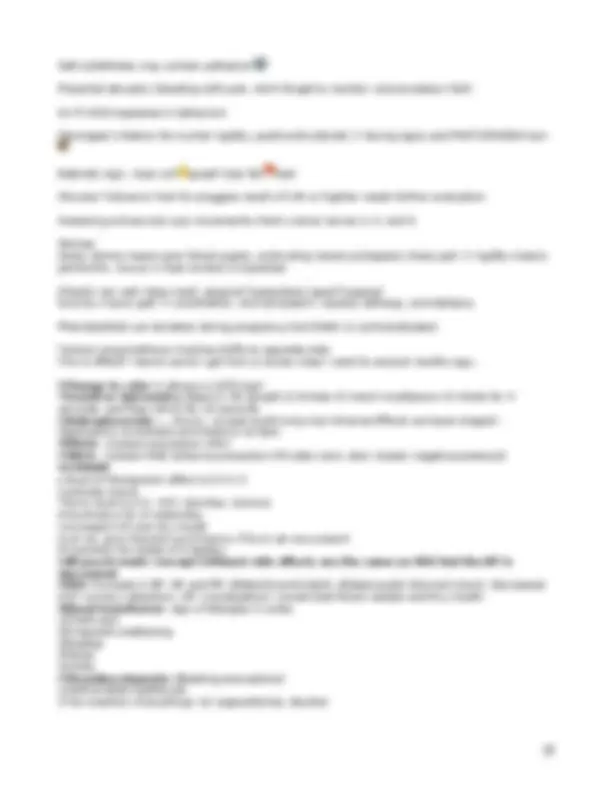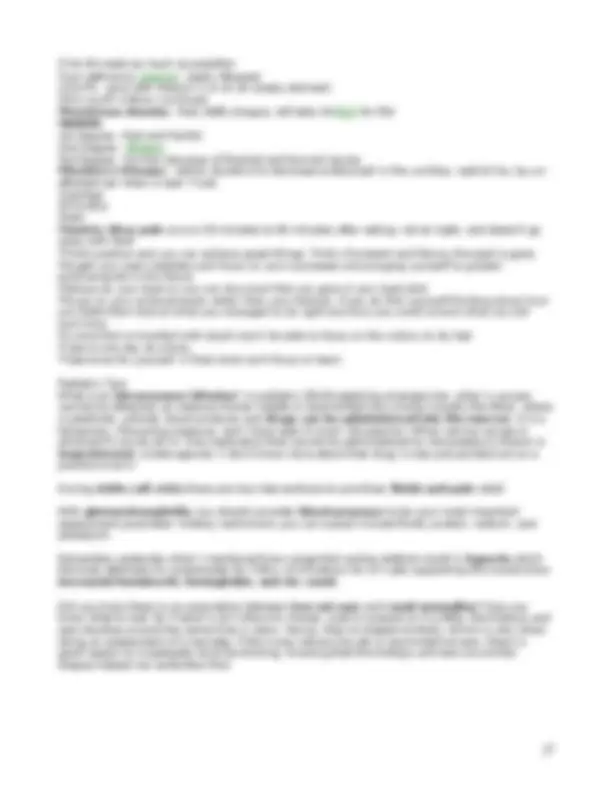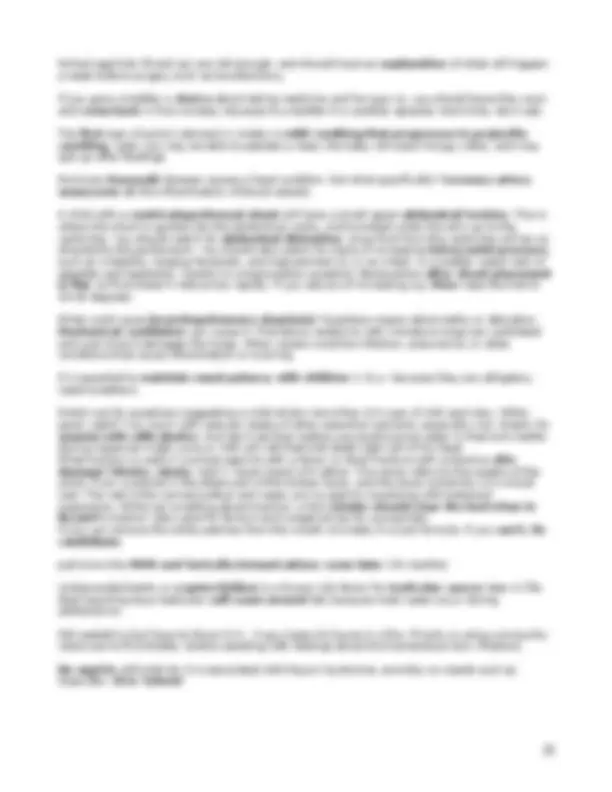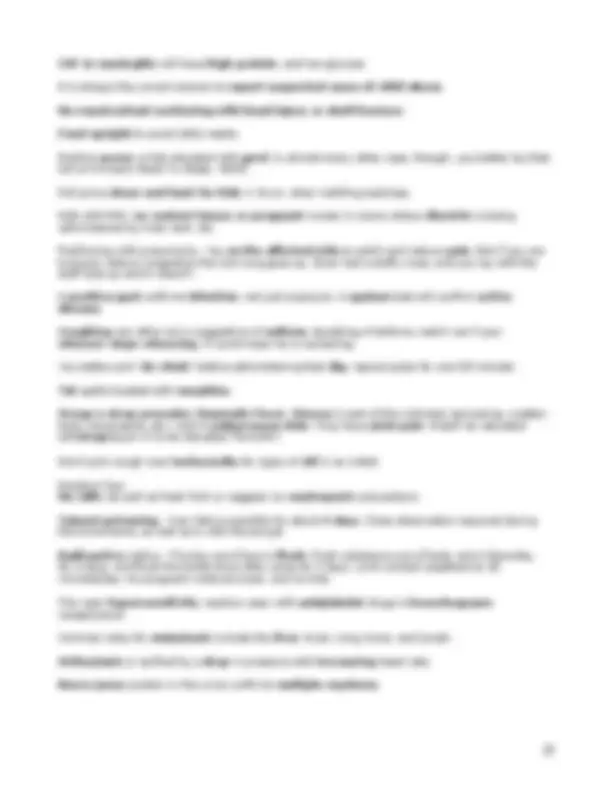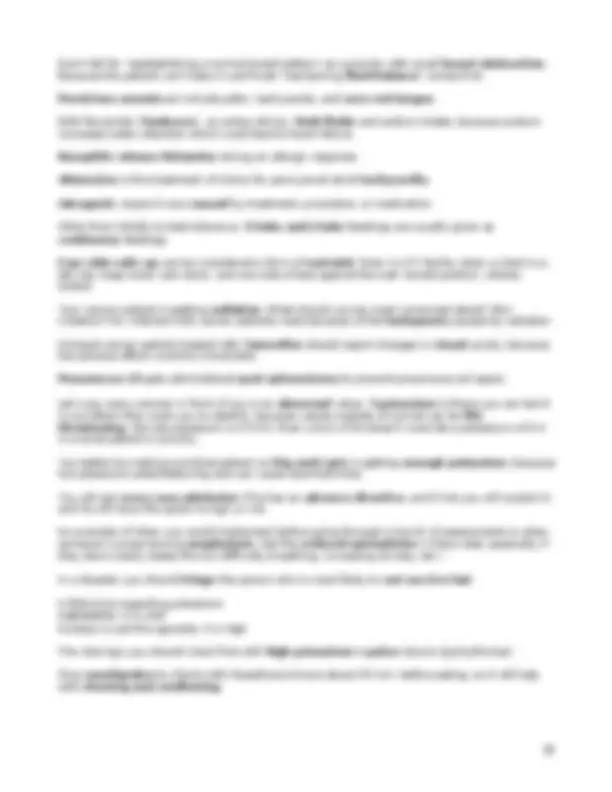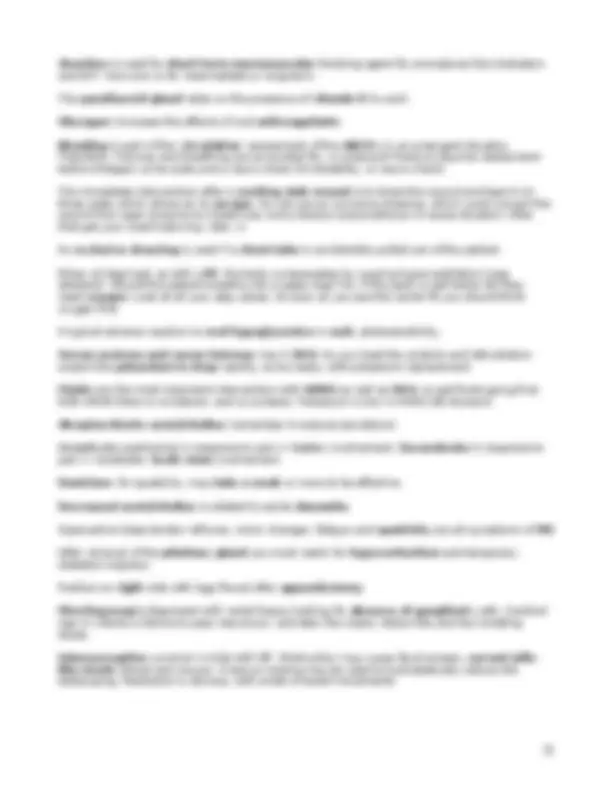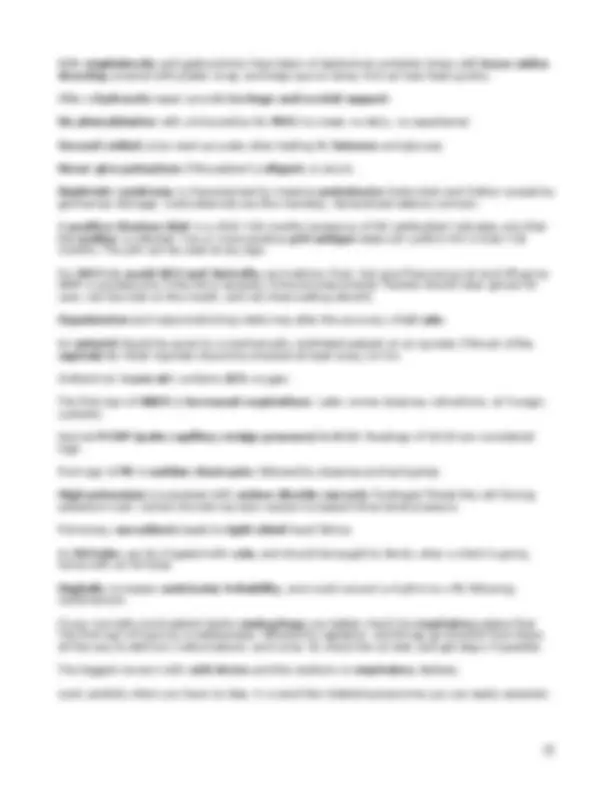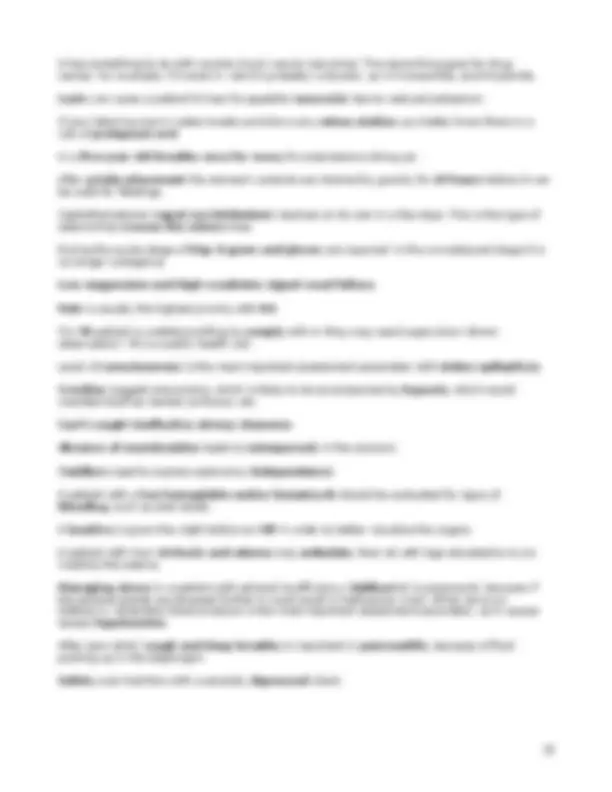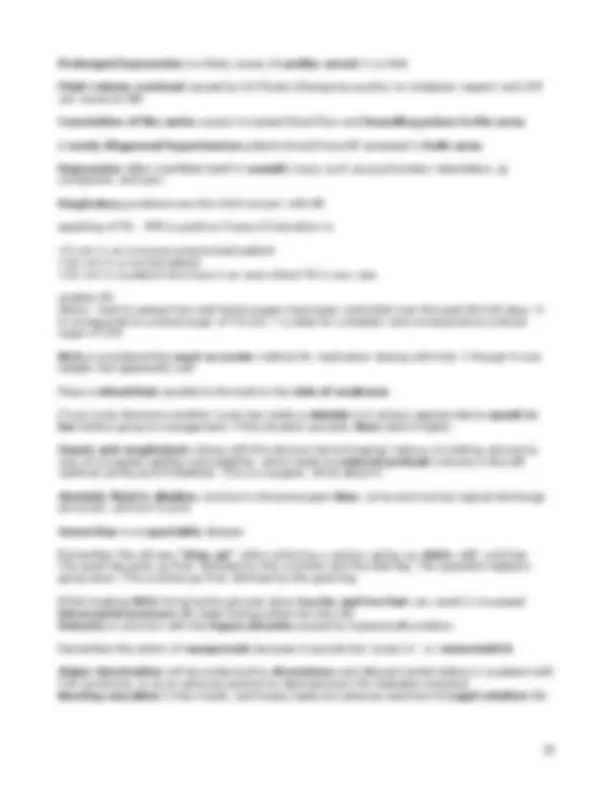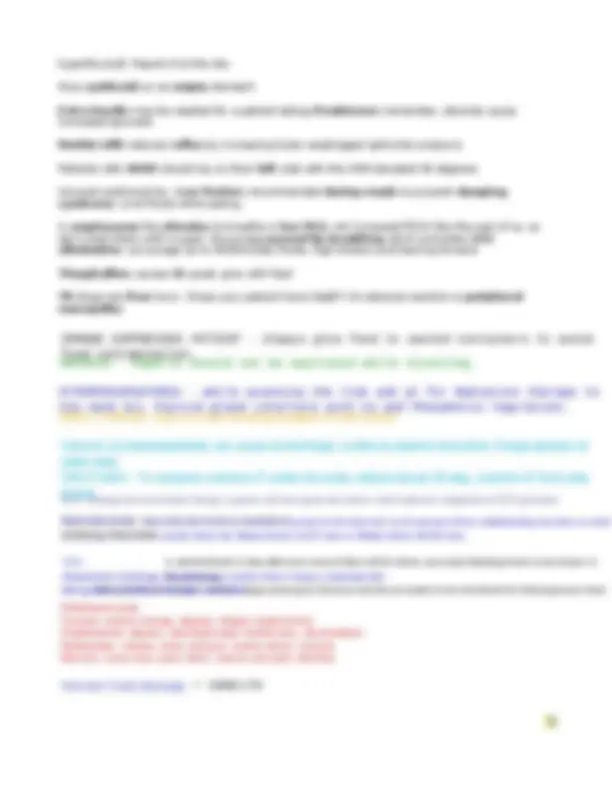Download NCLEX-RN EXAMINATION CRAM SHEET FOR NURSING STUDENTS. and more Exams Nursing in PDF only on Docsity!
Value Normal Range
BUN 10 – 25 or 5 - 25 Kaplan
Creatinine 1.2 – 1.5 or 0.5 – 1.5 Kap
Creatinine Clearance 85 – 135
Albumin, serum 3.5 – 5.
Potassium 3.5 – 5.
Specific Gravity 1.010 – 1.
Sodium, serum 135 – 145
Calcium 9 - 11
Magnesium 1.3 – 2.1 Critical < 0.5 or >
Chloride 95 – 105
Phosphate 3.0 – 4.
Serum Osmolarity 285 - 295
Glycosylated Hemoglobin 4 – 6% 3 month review of Glucose
pH 7.35 – 7.45 Acid Alkaline
HCO3 22 – 26 Acid Alkaline
PCO2 35 – 45 Acid Alkaline
PO2 80 – 100
O2 saturation 96 - 100
Metabolic Alkalosis pH , PCO2 , HCO3
Metabolic Acidosis pH , PCO2 , HCO3
Respiratory Alkalosis pH , PCO2 , HCO3
Respiratory Acidosis pH , PCO2 , HCO3
Phosphate 3.0 – 4.
CVP 3 – 11 or 2 – 8
HGB, hemoglobin 12 – 15
HCT, hemocrit 36 – 45
Platelets 150,000 – 450,
Neutrophils 2500 – 8000
Lymphocytes 1000 – 4000
RBC 3.2 – 5.
WBC 5000 – 10,
ESR 0 – 20
PTT 20 – 45 sec. Max 112 sec. Therapeutic. 1.5 – 2.5 times
PT/INR 10 – 14 seconds
Bilirubin 0.1 – 1.
ALT/AST 8 - 20
Digoxin 0.5 – 2 Toxic > 2.
Dilantin 10 – 20 Toxic > 30
Theophylline 10 - 20 Toxic > 20
Lithium 0.5 – 1.
Tylenol Toxic > 4000 mg/day
INR 2.0 - 3.
Sweat Test upto 60^ meq/L Central Venous Pressure 5-10cm of water Fetal H.R. 120 - 160 bpm with variation of 0-2bpm
DO NOT delegate what you can EAT! E - evaluate A - assess T - teach addisons= down, down down up down cushings= up up up down up addisons= hyponatremia, hypotension, decreased blood vol, hyperkalemia, hypoglycemia cushings= hypernatremia, hypertension, incrased blood vol, hypokalemia, hyperglycemia No Pee, no K (do not give potassium without adequate urine output) Ele V ate V eins; d A ngle A rteries for better perfusion A= appearance (color all pink, pink and blue, blue [pale]) P= pulse (>100, < 100, absent) G= grimace (cough, grimace, no response) A= activity (flexed, flaccid, limp) R= respirations (strong cry, weak cry, absent) TRANSMISSION-BASED PRECAUTIONS: AIRBORNE My - Measles Chicken - Chicken Pox/Varicella Hez - Herpez Zoster/Shingles TB or remember... MTV=Airborne Measles TB Varicella-Chicken Pox/Herpes Zoster-Shingles Private Room - negative pressure with 6-12 air exchanges/hr Mask, N95 for TB DROPLET think of SPIDERMAN! S - sepsis S - scarlet fever S - streptococcal pharyngitis P - parvovirus B P - pneumonia P - pertussis I - influenza D - diptheria (pharyngeal) E - epiglottitis R - rubella M - mumps M - meningitis M - mycoplasma or meningeal pneumonia An - Adenovirus Private Room or cohort Mask
- Infant w/ Cleft Lip --> position on back or in infant seat to prevent trauma to suture line. While feeding, hold in upright position.
- To Prevent Dumping Syndrome (post-operative ulcer/stomach surgeries) --> eat in reclining position, lie down after meals for 20-30 minutes (also restrict fluids during meals, low CHO and fiber diet, small frequent meals)
- Above Knee Amputation --> elevate for first 24 hours on pillow, position prone daily to provide for hip extension.
- Below Knee Amputation --> foot of bed elevated for first 24 hours, position prone daily to provide for hip extension.
- Detached Retina --> area of detachment should be in the dependent position
- Administration of Enema --> position pt in left side-lying (Sim's) with knee flexed
- After Supratentorial Surgery (incision behind hairline) --> elevate HOB 30-45 degrees
- After Infratentorial Surgery (incision at nape of neck)--> position pt flat and lateral on either side.
- During Internal Radiation --> on bedrest while implant in place
- Autonomic Dysreflexia/Hyperreflexia (S&S: pounding headache, profuse sweating, nasal congestion, goose flesh, bradycardia, hypertension) --> place client in sitting position (elevate HOB) first before any other implementation.
- Shock --> bedrest with extremities elevated 20 degrees, knees straight, head slightly elevated (modified Trendelenburg)
- Head Injury --> elevate HOB 30 degrees to decrease intracranial pressure
- Peritoneal Dialysis when Outflow is Inadequate --> turn pt from side to side BEFORE checking for kinks in tubing (according to Kaplan)
- Lumbar puncture => AFTER the procedure, the client should be placed in the supine position for 4 to 12 hrs as prescribed. (Saunders 3rd ed p. 229) Demorol for pancreatitis, NOT morphine sulfate Myasthenia Gravis: worsens with exercise and improves with rest. Myasthenia Crisis: a positive reaction to Tensilon--will improve symptoms Cholinergic Crisis: caused by excessive medication-stop med-giving Tensilon will make it worse Head injury medication: Mannitol (osmotic diuretic)-crystallizes at room temp so ALWAYS use filter needle Prior to a liver biospy its important to be aware of the lab result for prothrombin time From the a** (diarrhea)= metabolic acidosis From the mouth (vomitus)=metabolic alkalosis Myxedema/hypothyroidism : slowed physical and mental function, sensitivity to cold, dry skin and hair iMBP 2012-07-09 23:47:
Give ATROPINE SULFATE during Cholinergic crisis.
Graves’ disease/hyperthyroidism: accelerated physical and mental function; sensitivity to heat, fine/soft hair Thyroid storm: increased temp, pulse and HTN Post-thyroidectomy: semi-Fowler’s, prevent ncek flexion/hyperextension, trach at bedside Hypo-parathyroid: CATS – convulsions, arrhythmias, tetany, spasms, stridor (decreased calcium), high Ca, low phosphorus diet Hyper-parathyroid : fatigue, muscle weakness, renal calculi, back and joint pain (increased calcium), low Ca, high phosphorus diet Hypovolemia – incrased temp, rapid/weak pulse, increase respiration, hypotension, anxiety, urine specific gravity >1. Hypervolemia – bounding pulse, SOB, dyspnea, rares/crackles, peripheral edema, HTN, urine specific gravity <1.010; Semi-Fowler’s Diabetes Insipidus (decreased ADH): excessive urine output and thirst, dehydration, weakness, administer Pitressin SIADH (increased ADH): change in LOC, decreased deep tendon reflexes, tachycardia, n/v/a, HA; administer Declomycin, diuretics Hypokalemia : muscle ewakness, dysrhythmias, increase K (raisins, bananas, apricots, oranges, beans, potatoes, carrots, celery) Hyperkalemia: MURDER – muscle weakness, urine (oliguria/anuria), respiratory depression, decreased cardiac contractility, ECG changes, reflexes Hyponatremia : nausea, muscle cramps, increased ICP, muscular twitching, convulsion; osmotic diuretics, fluids Hypernatremia: increased temp, weakness, disorientation/delusions, hypotension,Mania,tachycardia; hypotonic solution Hypocalcemia: CATS – convulsions, arrhythmias, tetany, spasms and stridor Hypercalcemia : muscle weakness, lack of coordination, abdominal pain, confusion, absent tendon reflexes, sedative effect on CNS HypoMg : tremors, tetany, seizures, dyrshythmias, depression, confusion, dysphagia; dig toxicity HyperMg: depresses the CNS, hypotension, facial flushing, muscle ewakness, absent deep tendon reflexes, shallow respirations, emergency Addison’s : hypoNa, hyperK, hypoglycemia, dark pigmentation, decreased resistance to stress, fractures, alopecia, weight loss, GI distress Cushings: hyperNa, hypoK, hyperglycemia, prone to infection, muscle wasting, weakness, edema, HTN, hirsutism, moonface/buffalo hump Addisonian crisis: n/v, confusion, abdominal pain, extreme weakness, hypoglycemia, dehydration, decreased BP Pheochromocytoma : hypersecretion of epi/norepi, persistent HTN, increased HR, hyperglycemia, diaphoresis, tremor, pounding HA; avoid stress, frequent bating and rest breaks, avoid cold and stimulating foods, surgery to remove tumor
- Neuroleptic malignant syndrome (NMS): -NMS is like S&M; -you get hot (hyperpyrexia) -stiff (increased muscle tone) -sweaty (diaphoresis) -BP, pulse, and respirations go up & -you start to drool
Bactrim: antibiotic..dont take if allergic to sulfa drugs...diarrhea common side effect...drink plenty of fluids Gout Meds: Probenecid (Benemid), Colchicine, Allopurinol (Zyloprim) Apresoline(hydralazine)-tx of HTN or CHF, Report flu-like symptoms, rise slowly from sitting/lying position; take with meals. Bentyl: tx of irritable bowel......assess for anticholinergic side effects. Calan (verapamil): calcium channel blocker: tx of HTN, angina.....assess for constipation Carafate: tx of duodenal ulcers..coats the ulcer.....so take before meals. Theophylline: tx of asthma or COPD.. .therap drug level: 10- 20 Mucomyst is the antedote to tylenol and is administered orally Diamox: tx of glaucoma, high altitude sickness... .dont take if allergic to sulfa drugs Indocin: (nsaid) tx of arthritis (osteo, rhematoid, gouty), bursitis, and tendonitis. Synthroid: tx of hypothyroidism..may take several weeks to take effect.....notify doctor of chest pain..take in the AM on empty stomach..could cause hyperthyroidism. Librium: tx of alcohol w/d...dont take alchol with this......very bad nausea and vomiting can occur. Oncovin (vincristine): tx of leukemia..given IV ONLY kwell: tx of scabies and lice...(scabies)apply lotion once and leave on for 8-12 hours......(lice) use the shampoo and leave on for 4 minutes with hair uncovered then rinse with warm water and comb with a fine tooth comb Premarin:tx after menopause estrogen replacement Dilantin: tx of seizures. thera drug level: 10- Navane: tx of schizophrenia..assess for EPS Ritalin: tx of ADHD..assess for heart related side effects report immediately.....child may need a drug holiday b/c it stunts growth. dopamine (Intropine): tx of hypotension, shock, low cardiac output, poor perfusion to vital organs....monitor EKG for arrhythmias, monitor BP Have trouble remembering fhr patterns in OB? Think VEAL CHOP V C E H A O L P V = variable decels; C = cord compression caused E = early decels; H = head compression caused A = accels; O = okay, not a problem! L = late decels = placental insufficiency, can't fill
For cord compression, place the mother in the TRENDELENBERG position because this removes pressure of the presenting part off the cord. (If her head is down, the baby is no longer being pulled out of hte body by gravity) If the cord is prolapsed, cover it with sterile saline gauze to prevent drying of the cord and to minimize infection. For late decels, turn the mother to her left side, to allow more blood flow to the placenta. For any kind of bad fetal heart rate pattern, you give O2, often by mask... When doing an epidural anesthesia hydration before hand is a priority. Hypotension and bradypnea / bradycardia are major risks and emergencies. NEVER check the monitor or a machine as a first action. Always assess the patient first; for exmaple listen to the fetal heart tones with a stethoscope in NCLEX land. Sometimes it's hard to tell who to check on first, the mother or the baby; it's usually easy to tell the right answer if the mother or baby involves a machine. If you're not sure who to check first, and one of the choices involves the machine, that's the wrong answer. If the baby is a posterior presentation, the sounds are heard at the sides. If the baby is anterior, the sounds are heard closer to midline, between teh umbilicus and where you would listen to a posterior presentation. If the baby is breech, the sounds are high up in the fundus near the umbilicus. If the baby is vertex, they are a little bit above the symphysis pubis. Also for ventilator alarms HOLD H igh alarm- O bstruction due to incr. secretions, kink, pt. coughs, gag or bites L ow press alarm- D isconnection or leak in ventilatior or in pt. airway cuff, pt. stops spontaneous breathing
- to remember blood sugar: hot and dry-sugar high (hyperglycemia) cold and clammy-need some candy (hypoglycemia)
- ICP AND SHOCK HAVE OPPOSITE V/S ICP-increased BP, decreased pulse, decreased resp. shock- decreased BP, increased pulse, increased resp.
- cor pulmonae: right sided heart failure caused by left ventricular failure (so pick edema, jvd, if it is a choice.)
- herion withdrawal neonate: irratable poor sucking
- Jews: no meat and milk together
- Brachial pulse: pulse area cpr on an infant.
- Test child for lead poisioning around 12 months of age
- bananas, potatoes, citrus fruits source of potassium
- Cultures are obtained before starting IV antibiotics
blows the patient’s stimulus for breathing.
- exacerbation: acute, distress.
- epi always given in TB syringe.
- prednisone toxicity: cushing’s syndrome= buffalo hump, moon face, high glucose, hypertension.
- 4 options for cancer management: chemo, radiation, surgery, allow to die with dignity.
- no live vaccines, no fresh fruits, no flowers should be used for neutropenic patients.
- chest tubes are placed in the pleural space.
- angina (low oxygen to heart tissues) = no dead heart tissues. MI= dead heart tissue present.
- mevacor (anticholesterol med) must be given with evening meal if it is QD (per day).
- Nitroglycerine is administered up to 3 times (every 5 minutes). If chest pain does not stop go to hospital. Do not give when BP is < 90/60.
- Preload affects amount of blood that goes to the R ventricle. Afterload is the resistance the blood has to overcome when leaving the heart.
- Calcium channel blocker affects the afterload.
- for a CABG operation when the great saphenous vein is taken it is turned inside out due to the valves that are inside.
- unstable angina is not relieved by nitro.
- dead tissues cannot have PVC’s(premature ventricular contraction. If left untreated pvc’s can lead to VF (ventricular fibrillation).
- 1 t (teaspoon)= 5 ml 1 T(tablespoon)= 3 t = 15 ml 1 oz= 30 ml 1 cup= 8 oz 1 quart= 2 pints 1 pint= 2 cups 1 gr (grain)= 60 mg 1 g (gram)= 1000 mg 1 kg= 2.2 lbs 1 lb= 16 oz
- To convert Centigrade to F. F= C+40, multiply 9/5 and substract 40
- To convert Fahrenheit to C. C= F+40, multiply 5/9 and substract 40.
- angiotensin II in the lungs= potent vasodialator. Aldosterone attracts sodium.
- REVERSE AGENTS FOR TOXICITY heparin= protamine sulfate coumadin= vitamin k ammonia= lactulose acetaminophen= n- Acetylcysteine. Iron= deferoxamine Digitoxin, digoxin= digibind. Alcohol withdraw= Librium.
- methadone is an opioid analgesic used to detoxify/treat pain in narcotic addicts.
- Potassium potentiates dig toxicity.
- heparin prevents platelet aggregation.
- PT/PTT are elevated when patient is on coumadin
- cardiac output decreases with dysrythmias. Dopamine increases BP.
- Med of choice for Ventricular Tachycardia LIDOCAINE
- Med of choice for SVT is adenosine or adenocard
- Med of choice for Asystole (no heart beat) is atropine
- Med of choice for CHF is Ace inhibitor.
- Med of choice for anaphylactic shock is Epinephrine
- Med of choice for Status Epilepticus is Valium.
- Med of choice for bipolar is lithium.
- Amiodorone is effective in both ventricular and atrial complications.
- S3 sound is normal in CHF, not normal in MI.
- give carafate (GI med) before meals to coat stomach
- Protonix is given prophylactically to prevent stress ulcers.
- after endoscopy check gag reflex.
- TPN(total parenteral nutrition) given in subclavian line.
- low residue diet means low fiver
- diverticulitis (inflammation of the diverticulum in the colon) pain is around LL quadrant.
- Appendicitis (inflammation of the appendix) pain is in RL quadrant with rebound tenderness.
- portal hypotension + albuminemia= Ascites.
- beta cells of pancreas produce insulin
- Morphine is contraindicated in Pancreatitis. It causes spasm of the Sphincter of Oddi. Therefore Demerol should be given.
- Trousseau and Tchovoski signs observed in hypocalcemia
- with chronic pancreatitis, pancreatic enzymes are given with meals.
- Never give K+ in IV push.
- mineral corticoids are give in Addison’s disease.
- Diabetic ketoacidosis (DKA)= when body is breaking down fat instead of sugar for energy. Fats leave ketones (acids) that cause pH to decrease.
- DKA is rare in diabetes mellitus type II because there is enough insulin to prevent breakdown of fats.
- Sign of fat embolism is petechiae. Treated with heparin.
- for knee replacement use continuous passive motion machine.
- give prophylactic antibiotic therapy before any invasive procedure.
- glaucoma patients lose peripheral vision. Treated with meds
- cataract= cloudy, blurry vision. Treated by lens removal-surgery
- Co2 causes vasoconstriction.
- most spinal cord injuries are at the cervical or lumbar regions
- autonomic dysreflexia ( life threatening inhibited sympathetic response of nervous system to a noxious stimulus- patients with spinal cord injuries at T-7 or above) is usually caused by a full bladder.
- spinal shock occurs immediately after spinal injury
- Multiple sclerosis= myelin sheat destruction, disruption in nerve impulse conduction.
- myasthenia gravis= decrease in receptor sites for acetylcholine. Since smallest concentration of ACTH receptors are in cranial nerves, expect fatigue and weakness in eye, mastication, pharyngeal muscles.
- Tensilon test given if muscle is tense in myasthenia gravis.
- Guillain-Barre syndrome= ascending paralysis. Keep eye on respiratory system.
- parkinson’s = RAT: rigidity, akinesia (loss of muscle mvt), tremors. Treat with levodopa.
- TIA (transient ischemic attack) mini stroke with no dead brain tissue
- CVA (cerebrovascular accident) is with dead brain tissue.
- Hodgkin’s disease= cancer of lymph is very curable in early stage.
- Rule of NINES for burns Head and Neck= 9% Each upper ext= 9% Each lower ext= 18%
-establish trusting relationship
- meds -leas restrictive methods/environment.
- SSRI’s (antidepressants) take about 3 weeks to work.
- Obsession is to thought. Compulsion is to action
- if patients have hallucinations redirect them. In delusions distract them.
- Thorazine, haldol (antipsychotic) can lead to EPS (extrapyramidal side effects)
- Alzheimer’s disease is a chronic, progressive, degenerative cognitive disorder that accounts for more than 60% of all dementias
- To remember how to draw up INSULIN think: N icole R ichie RN (a teacher taught us this is school, thought it was funny and never forgot it!!!) Air into NPH, then air into regular, draw up regular then draw up NPH
- HYPERthyroidism think of MICHAEL JACKSON in THRILLER! SKINNY, NERVOUS, BULDGING EYES , Up all night, heart beating fast Atropine used to decrease secretions Phenergan an antiemetic used to reduce nausea Diazepam is a commonly used tranquilizer given to reduce anxiety before OR Demerol is for pain control Do not give demerol to pts. with sickle cell crisis. Iron injections should be given Z-track so they don't leak into SQ tissues. A ll P hysicians E arn T oo M uch M oney Or APE T o M an Cranial Nerves : *I am sorry if this vulgar for some, but hey, it sticks Sensory=S Motor=M Both=B Oh (Olfactory I) Some Oh (Optic II) Say Oh (Oculomotor III) Marry To (Trochlear IV) Money Touch (Trigeminal V) But And (Abducens VI) My Feel (Facial VII) Brother A (Auditory VIII) Says Girls (Glossopharyngeal IX) Big Vagina (Vagus X) Bras And (Accessory XI) Matter Hymen (Hypoglassal XII) More
Hyper natremia (greater than 145) S kin flushed A gitation L ow grade fever T hirst Developmental 2-3 months: turns head side to side 4-5 months: grasps, switch & roll 6-7 months: sit at 6 and waves bye-bye 8-9 months: stands straight at eight 10-11 months: belly to butt (phrase has 10 letters) 12-13 months: twelve and up , drink from a cup Hepatitis Hepatitis: -ends in a VOWEL , comes from the BOWEL (Hep A) Hepatitis B=Blood and Bodily fluids Hepatitis C is just like B Apgar measures HR,RR,Muscle tone, Reflexes,Skin color each 0-2 point. 8-10 OK. 0-3 RESUSCITATE. GLASGOW COMA SCALE. EYES, VERBAL,MOTOR! It is similar to measuring dating skills... max 15 points -one can do it if below 8 you are in Coma. So, to start dating you gotta open your EYES first , if you albe to do that spontaneously and use them correctly to SEE whom you dating you earn 4. But if she has to scream on you to make you open them it is only 3 ......and 1 you dont care to open even if she tries to hurt you. if you get good EYE contact (4 points) then move to VERBAL. talk to her/ him! if you can do that You are really ORIENTED in situation she/he uncontiously gives you 4 points! if you like her try not to be CONFUSED (3), and of cause do not use INAPPROPRIATE WORDS (3), she will not like it)), try not to RESPOND WITH INCOMPREHENSIBLE SOUNDS (2), if you do not like her- just show no VERBAL RESPONSE(1) Since you've got EYE and VERBAL contact you can MOVE now using your Motor Response Points. THis is VERY important since Good moves give you 6! The person who hyperventilates is most likely to experience respiratory alkalosis. avoid salt substitutes when taken dig and k-supplements because many are potassium based Signs of hypoxia: restless, anxious, cyanotic tachycardia, increased resps. (also monitor ABG's) Addison's disease (need to "add" hormone) Cushing's syndrome (have extra "cushion" of hormones) Dumping syndrome: increase fat and protein, small frequent meals, lie down after meal to decrease peristalsis, wait 1 hr after meals to drink.
- R ifampin - R ed orange tears and urine, also contraceptives don't work as well
- E thambutol - messes with your E yes
- Apply eye drop to conjunctival sac and after wards apply pressure to nasolacrimal duct / inner canthus
- Pancreatitis patients but them in fetal position, NPO, gut rest, prepare antecubital site for PICC cuz they'll probably be getting TPN/Lipids
- Trendelenburg test - for varicose veins. If they fill proximally = varicosity. Rule of nines, 9 = head, 18 = arms, 36 = torso, 36 =legs, and 1= perineum = 100% When giving Kayexalate we need to worry about dehydration ( K ha ineverse relationship with Na) Yogurt has live cultures- dont give to immunosuppressed pt Itching under cast area- cool air via blow dryer, ice pack for 10- 15 minutes. NEVER use qtip or anything to scratch area Murphy’s sign – pain with palpation of gall bladder area seen with cholecystitis Cullen’s sign – ecchymosis in umbilical area, seen with pancreatitis Turner’s sign – flank grayish blue (turn around to see your flanks) pancreatitis McBurney’s Point – pain in RLQ indicative of appendicitis LLQ – diverticulitis , low residue, no seeds, nuts, peas RLQ
- appendicitis, watch for peritonitis Guthrie Test – Tests for PKU, baby should have eaten source of protein first Shilling Test – test for pernicious anemia/ how well one absorbs Vit b Allen’s test – occlude both ulnar and radial artery until hand blanches then release ulnar. If the hand pinks up, ulnar artery is good and you can carry on with ABG/radial stick as planned. ABGS must be put on ice and whisked to the lab. oIt’s ok to have abdominal craps, blood tinged outflow and leaking around site if the Peritoneal Dialysis cath (tenkhoff) was placed in the last 1-2 wks. Cloudy outflow NEVER NORMAL. oAmniotic fluid yellow with particles = meconium stained oHyper reflexes (upper motor neuron issue “your reflexes are over the top”) oAbsent reflexes (lower motor neuron issue) oRhogam : given at 28 weeks, 72 hours post partum, IM. Only given to Rh NEGATIVE mother. Also if indirect Coomb’s test is positive, don’t need to give Rhogam cuz she has antibody only give if negative coombs oVit K is to coumadin as Protamine Sulfate is to Heparin as Ca Glu is to MgSo4 as Mucomyst is to Acetominophen as Amicar is to TPA(Urokinase given for MI)..get it? Antidotes/tx for overdose Order of assessment: Inspection, Palpation, Percussion and Ausculation. EXCEPT with abdomen cuz you don’t wanna mess with the bowels and their sounds so you Inspect, Auscultate, Percuss then Palpate (same with kids, I suppose since you wanna go from least invasive to most invasive sine they will cry BLOOD MURDER! Gotta love them kids !) Latex allergies => Assess for allergies to bananas, apricots, cherries, grapes, kiwis, passion fruit, avocados, chestnuts, tomatoes, peaches
Tensilon is used in myesthenia gravis to confirm the diagnosis. Myesthenia gravis is caused by a disorder in the transmission of impulses from nerve to muscle cell. Amyotrophic lateral sclerosis ( ALS ) is a condition in which there is a degeneration of motor neurons in both the upper & lower motor neuron systems. Transesophageal Fistula (TEF) - esophagus doesn't fully develop (this is a surgical emergency) The 3 C's of TEF in the newborn:
- Choking
- Coughing
- Cyanosis The MMR vaccine is given SQ not IM. Red--unstable, ie, occluded airway, actively bleeding, see first Yellow---stable, can wait up to an hour for treatment, ie burns, see second Green---stable, can wait even longer to be seen, "walking wounded" Black--unstable clients that will probably not make it, need comfort measures DOA---dead on arrival Greek heritage - they put an amulet or any other use of protective charms around their baby's neck to avoid "evil eye" or envy of others 4 year old kids cannot interpret TIME. Need to explain time in relationship to a known COMMON EVENT (eg: "Mom will be back after supper"). ** Anaphylactic reaction to baker's yeast is contraindication for Hep B vaccine. ** Ask for allergy to eggs before Flu shot ** Ask for anaphylactic rxn to eggs or neomycin before MMR ** When on nitroprusside, monitor thiocynate (cyanide). Normal value should be 1, >1 is heading toward toxicity **If kid has cold, can still give immunizations **SARS (severe acute resp syndrome) airborne + contact (just like varicella) ** Hepatitis A is contact precautions ** Tetanus, Hepatitis B, HIV are STANDARD precautions ** William's position - Semi Fowlers with knees flexed (inc. knee gatch) to relieve lower back pain. ** SIGNS of a Fractured hip: EXTERNAL ROTATION, SHORTENING, ADDUCTION ** Fat Embolism: Blood tinged sputum (r/t inflammation), inc ESR, respiratory alkalosis (not acidosis r/t tachypnea), hypocalcemia,increased serum lipids, "snow storm" effect on CXR. **Complications of Mechanical Ventilation: Pneumothorax, Ulcers ** Paget's Disease - tinnitus, bone pain, enlargement of bone, thick bones. ** NO VITAMIN C with Allopurinol ** IVP requires bowel prep so they can visualize the bladder better **Acid Ash diet - cheese, corn, cranberries, plums, prunes, meat, poultry, pastry, bread ** Alk Ash diet- milk, veggies, rhubarb, salmon ** Orange tag in triage is non emergent Psych ** Greenstick fractures, usually seen in kids bone breaks on one side and bends on the other
Dexedrine, used for ADHD, may alter insulin needs, avoid taking with MAOI's, take in morning (insomnia possible side effect) Cytovene, used for retinitis caused by cytomegalovirus, pt will need regular eye exams, report dizziness, confusion, or seizures immediately INH, used to treat and prevent TB, do not give with dilantin, can cause phenytonin toxicity, monitor LFT's, give B6 along with, hypotension will occur initially, then resolve Rifampin, for TB, dyes bodily fluids orange If mixing antipsychotics (ie Haldol, Throazine, Prolixin) with fluids, med is incompatible with caffine and apple juice Haldol preferred anti-psychotic in elderly, but high risk extrapyramidal side effects (dystonia, tarditive dyskinesia, tightening of jaw, stiff neck, swollen tongue, later on swollen airway), monitor for early signs of reaction and give IM Benadryl Risperdal, antipsychotic, doses over 6mg can cause tarditive dyskinesia, first line antipsychotic in children Levodopa, for parkinsons, contraindicated in pts with glaucoma, avoid B Sinemet, for parkinsons, contraindicated with MAOI's Hydroxyurea, for sickle cell, report GI symptoms immediately, could be sign of toxicity Zocor, for hyperlipidemia, take on empty stomach to enhance absorption, report any unexplained musle pain, especially if fever Decorticate is toward the 'cord'. Decerebrit is the other way (out) ** BOTOX ** (Botulin Toxin) can be used with strabismus also to relax vocal cords in spasmodic dysphonia.
- Munchausen Syndrome is a psychiatric disorder that causes an individual to self-inflict injury or illness or to fabricate symptoms of physical or mental illness, in order to receive medical care or hospitalization. In a variation of the disorder, Munchausen by proxy (MSBP) , an individual, typically a mother, intentionally causes or fabricates illness in a child or other person under her care.
- Multiple Sclerosis is a chronic, progressive disease with demyelinating lesions in the CNS which affect the white matter of the brain and spinal cord. Motor S/S: limb weakness, paralysis, slow speech Sensory S/S: numbness, tingling, tinnitus Cerebral S/S: nystagmus, ataxia, dysphagia, dysarthria Huntington's Chorea: 50% genetic, autosomal dominant disorder S/S: chorea --> writhing, twisting, movements of face, limbs and body -gait deteriorates to no ambulation -no cure, just palliative care -WBC shift to the left in a patient with pyelonephritis (neutrophils kick in to fight infection) -Definitive diagnosis for abd. aortic aneurysm (AAA) --> CT scan -Don't use Kayexalate if patient has hypoactive bowel sounds. -Uremic fetor --> smell urine on the breath -Hirschsprung’s --> bile is lower obstruction, no bile is upper obstruction; ribbon like stools. -Pancreatic enzymes are taken with each meal! Not before, not after, but WITH each meal.

